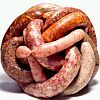I'm due to make another batch of pickled eggs (typically doing around 60 per session) for a long seal & sit in a dark larder, & am looking for forum members experience with smoking raw eggs, in order that I can try smoked boiled & get some raw smoked at the same time.
used the search facility, but didn't turn up anything, so does anyone have any pointers please? ..the only reference I found was a NZ site blog which had manuka chip smoked raw eggs in shells.
(obviously the shells are porus, however the accompanying picture showed very darkened eggs, to which I imagine they were done in a more ad-hoc manner than my own csg set up).
http://sundayhotpants.nocturne.net.nz/post/350369663/manuka-smoked-eggs ..these apparantly are smoked for 6 hours.
Raw smoked eggs (in shells)
26 posts
• Page 1 of 2 • 1, 2
Raw smoked eggs (in shells)
Mac's ProQ CSG devotee.
Founder member of "Cheese club" ...it's like "Fight Club" only cheesier
Avatar courtesy of Thad Cox https://twitter.com/LimitedFun http://limitedfun.tumblr.com/
Founder member of "Cheese club" ...it's like "Fight Club" only cheesier
Avatar courtesy of Thad Cox https://twitter.com/LimitedFun http://limitedfun.tumblr.com/
-

GUS - Registered Member
- Posts: 600
- Joined: Sun May 26, 2013 1:05 pm
- Location: Cambridgeshire U.K.
Re: Raw smoked eggs (in shells)
I've only ever smoked them after boiling. I would think that they'd be great if they can be smoked pre-boil as the flavour should be right through them.
Phil
Phil
-

wheels - Global Moderator
- Posts: 12894
- Joined: Sat Sep 02, 2006 4:29 pm
- Location: Leicestershire, UK
Re: Raw smoked eggs (in shells)
I will line some up along with some butter & honey & give them a blast.
Cheers wheels
Cheers wheels
Mac's ProQ CSG devotee.
Founder member of "Cheese club" ...it's like "Fight Club" only cheesier
Avatar courtesy of Thad Cox https://twitter.com/LimitedFun http://limitedfun.tumblr.com/
Founder member of "Cheese club" ...it's like "Fight Club" only cheesier
Avatar courtesy of Thad Cox https://twitter.com/LimitedFun http://limitedfun.tumblr.com/
-

GUS - Registered Member
- Posts: 600
- Joined: Sun May 26, 2013 1:05 pm
- Location: Cambridgeshire U.K.
Re: Raw smoked eggs (in shells)
Is smoking raw eggs common? I'd be worried about possibly culturing Salmonella, among other things.
-

vagreys - Site Admin
- Posts: 1653
- Joined: Sun Oct 29, 2006 3:54 pm
- Location: North Chesterfield VA USA
Re: Raw smoked eggs (in shells)
Yep, it's a possibility, but when I think of all the years we kept eggs on the dresser in the kitchen with no (apparent) adverse affect, I would hope that it would be minimal.
Now, I don't want to be seen in the "My grandma did it and lived to 85" brigade and fully acknowledge that would be a calculated risk. This may be of interest:
http://www.dailymail.co.uk/news/article ... -best.html
So, in the UK, 'Lion branded' eggs are probably OK. For overseas members, that's a well loved certification system that's shown by printing a little lion on the egg:
http://www.lioneggfarms.co.uk/default.aspx
That said, they're probably still best avoided by people in "medically at risk" groups.
Phil
Now, I don't want to be seen in the "My grandma did it and lived to 85" brigade and fully acknowledge that would be a calculated risk. This may be of interest:
http://www.dailymail.co.uk/news/article ... -best.html
So, in the UK, 'Lion branded' eggs are probably OK. For overseas members, that's a well loved certification system that's shown by printing a little lion on the egg:
http://www.lioneggfarms.co.uk/default.aspx
That said, they're probably still best avoided by people in "medically at risk" groups.
Phil
-

wheels - Global Moderator
- Posts: 12894
- Joined: Sat Sep 02, 2006 4:29 pm
- Location: Leicestershire, UK
Re: Raw smoked eggs (in shells)
A night in the smoker (full burn) & nothing in terms of colour to the shell, so will assume the worst & reload then work back once smoke permeability has been ascertained.
One niggle, & probably a "how long is a piece of string moment" ..what is the perceived standard output measurement of the csg? (species of woods aside) & how to up it's output, because one persons smoke output isn't another, we need some form of sliding scale to relate times from a traeger for instance to an amazin / csg etc, I think i'd be smokin eggs till the next flood otherwise based on those charred pics (above).
One niggle, & probably a "how long is a piece of string moment" ..what is the perceived standard output measurement of the csg? (species of woods aside) & how to up it's output, because one persons smoke output isn't another, we need some form of sliding scale to relate times from a traeger for instance to an amazin / csg etc, I think i'd be smokin eggs till the next flood otherwise based on those charred pics (above).
Mac's ProQ CSG devotee.
Founder member of "Cheese club" ...it's like "Fight Club" only cheesier
Avatar courtesy of Thad Cox https://twitter.com/LimitedFun http://limitedfun.tumblr.com/
Founder member of "Cheese club" ...it's like "Fight Club" only cheesier
Avatar courtesy of Thad Cox https://twitter.com/LimitedFun http://limitedfun.tumblr.com/
-

GUS - Registered Member
- Posts: 600
- Joined: Sun May 26, 2013 1:05 pm
- Location: Cambridgeshire U.K.
- derekmiller
- Registered Member
- Posts: 27
- Joined: Wed Mar 13, 2013 4:54 pm
- Location: Cotton End, Beds, UK.
Re: Raw smoked eggs (in shells)
Thanks Dm, another site I need to speed-read (in case the wife catches me & accuses me of being an obsessive)
Mac's ProQ CSG devotee.
Founder member of "Cheese club" ...it's like "Fight Club" only cheesier
Avatar courtesy of Thad Cox https://twitter.com/LimitedFun http://limitedfun.tumblr.com/
Founder member of "Cheese club" ...it's like "Fight Club" only cheesier
Avatar courtesy of Thad Cox https://twitter.com/LimitedFun http://limitedfun.tumblr.com/
-

GUS - Registered Member
- Posts: 600
- Joined: Sun May 26, 2013 1:05 pm
- Location: Cambridgeshire U.K.
Re: Raw smoked eggs (in shells)
You could, of course, smoke the eggs after boiling and peeling. 
Phil
Phil
-

wheels - Global Moderator
- Posts: 12894
- Joined: Sat Sep 02, 2006 4:29 pm
- Location: Leicestershire, UK
Re: Raw smoked eggs (in shells)
wheels wrote:Yep, it's a possibility, but when I think of all the years we kept eggs on the dresser in the kitchen with no (apparent) adverse affect, I would hope that it would be minimal...That said, they're probably still best avoided by people in "medically at risk" groups.
I grew up on a farm, and we kept our eggs out and unwashed until just before use. As the article suggests, they kept fine, and we never had a problem with bacteria. My understanding has always been that the natural pellicle on the surface of the shell made it effectively impermeable, even to external gram-negative bacteria. The argument against washing the eggs being that the pellicle is removed, unsealing the porous shell, and allowing bacteria to penetrate. Here, some organic sources for eggs do not vaccinate, so the possibility of Salmonella-laced eggs is a potential risk. Being immuno-suppressed, I do admit to the "medically at risk" bias. The idea of smoked raw eggs is intriguing, though.
GUS wrote:A night in the smoker (full burn) & nothing in terms of colour to the shell, so will assume the worst & reload then work back once smoke permeability has been ascertained...
In your original article, it described the eggs as being tacky, with the dark surface of the eggs being sticky and the smoke deposit coming off on the fingers. To me, that says 'soot' and 'tar', and I got the impression of an inefficient burn with heavy smoke, not the thin, blue smoke of a maze-type csg; however, I freely admit that I have no idea how manuka wood burns to achieve that kind of heavy smoke deposit.
GUS wrote:...One niggle, & probably a "how long is a piece of string moment" ..what is the perceived standard output measurement of the csg? (species of woods aside) & how to up it's output, because one persons smoke output isn't another, we need some form of sliding scale to relate times from a traeger for instance to an amazin / csg etc, I think i'd be smokin eggs till the next flood otherwise based on those charred pics (above).
When I went out to BC, in August, some friends asked me to do some pork barbecue for a couple of hundred folks, and the rig they had rented was a Traeger XL full of pecan pellets. This was my first experience with a Traeger, and I was cooking low and slow (so, not at the typical temps Traeger suggests). I noticed a couple of things. Unlike an Amazen or CSG, the Traeger was using pellets for heat as well as smoke, and the "smoke" (lowest) setting was keeping the smoker at about 140°F in a chilly, damp environment. And it was achieving an efficient burn via forced air fireboxes. Not sure one could relate a maze-type cold smoke generator with something like a Traeger in terms of smoke output - such different animals. In the Amazen (don't know about the CSG), there is a hole at each end of the maze, so one can light both ends, thereby doubling the output and halving the smoke duration, but I have no idea how to quantify the 'standard' output. A good question. Smoke canisters are rated in terms of cubic volumes of smoke. A unit like that would probably allow one to relate smoke generation in terms common to cold- and hot-smoke generators, alike, for smoke volume generated for a standard load; but, a better unit might be a unit of volume over time, to relate the smoke-generating rates of different smoke sources. A greater challenge would be quantifying the quality of the 'standard' burn, and that gets us back to the question of what the quality of burn was that put such a dark deposit on the outside of those manuka-smoked eggs. It almost certainly wasn't thin, blue smoke.
-

vagreys - Site Admin
- Posts: 1653
- Joined: Sun Oct 29, 2006 3:54 pm
- Location: North Chesterfield VA USA
Re: Raw smoked eggs (in shells)
Some great points made there, Tom.
The size of container, size of chimney, and ambient conditions will also affect the throughput of smoke.
Phil
The size of container, size of chimney, and ambient conditions will also affect the throughput of smoke.
Phil
-

wheels - Global Moderator
- Posts: 12894
- Joined: Sat Sep 02, 2006 4:29 pm
- Location: Leicestershire, UK
Re: Raw smoked eggs (in shells)
Food for thought indeed Vagreys, sounds like the Traeger(s) may well be quite an efficiently designed beast.
Forced air & a semi automated temp control design are something I wish law would allow over here in terms of WBS (woodburners) ..though obviously we do have automated pellet burners for heating here (complicated beasts, & large amounts of careful storage for the pellets, not to mention pcb replacements etc as it gets more hi-tech.
Yup, not knowing the process of burning manuka (guessing with the tarring it must be like burning Lleyandii Cypressus (sic) conifers (horrible) or the blackness was not far off cooking them, ..something of a concern unless holding the full facts, somewhat disconcerting.
your volume & time output idea seems to fit the bill nicely.
Smoke 2 almost done nothing but the merest stain from the chamber's build up, will pull a 3rd cook & see what effect if any.
Cheers for the input.
Forced air & a semi automated temp control design are something I wish law would allow over here in terms of WBS (woodburners) ..though obviously we do have automated pellet burners for heating here (complicated beasts, & large amounts of careful storage for the pellets, not to mention pcb replacements etc as it gets more hi-tech.
Yup, not knowing the process of burning manuka (guessing with the tarring it must be like burning Lleyandii Cypressus (sic) conifers (horrible) or the blackness was not far off cooking them, ..something of a concern unless holding the full facts, somewhat disconcerting.
your volume & time output idea seems to fit the bill nicely.
Smoke 2 almost done nothing but the merest stain from the chamber's build up, will pull a 3rd cook & see what effect if any.
Cheers for the input.
Mac's ProQ CSG devotee.
Founder member of "Cheese club" ...it's like "Fight Club" only cheesier
Avatar courtesy of Thad Cox https://twitter.com/LimitedFun http://limitedfun.tumblr.com/
Founder member of "Cheese club" ...it's like "Fight Club" only cheesier
Avatar courtesy of Thad Cox https://twitter.com/LimitedFun http://limitedfun.tumblr.com/
-

GUS - Registered Member
- Posts: 600
- Joined: Sun May 26, 2013 1:05 pm
- Location: Cambridgeshire U.K.
Re: Raw smoked eggs (in shells)
Zero success.
Having given them 3 full term hits in the csg, i'm also of the opinion, based on the original article picture that no smoke penetrates, but prolonged tar probably gets in & results in the flavour the writer mentions.
My 2 eggs were not sticky, or greasy, there was residue but nothing like the char of the photo, & very insignificant shell change bearing in mind 30+ hours.
I can only guess in conclusion that the wood burnt / used is very oily & close to the point of burn & greatly increased smoke density than the CSG can put out.
The shell smelt good, upon cracking & popping the old nose in, it smelt like transfer had occurred but a wet 30 second poach, drained had zero scent or smoke passed to the tongue.
Anyone speculate further as to Manuka itself? as I guess it'll be the reveal!
Having given them 3 full term hits in the csg, i'm also of the opinion, based on the original article picture that no smoke penetrates, but prolonged tar probably gets in & results in the flavour the writer mentions.
My 2 eggs were not sticky, or greasy, there was residue but nothing like the char of the photo, & very insignificant shell change bearing in mind 30+ hours.
I can only guess in conclusion that the wood burnt / used is very oily & close to the point of burn & greatly increased smoke density than the CSG can put out.
The shell smelt good, upon cracking & popping the old nose in, it smelt like transfer had occurred but a wet 30 second poach, drained had zero scent or smoke passed to the tongue.
Anyone speculate further as to Manuka itself? as I guess it'll be the reveal!
Mac's ProQ CSG devotee.
Founder member of "Cheese club" ...it's like "Fight Club" only cheesier
Avatar courtesy of Thad Cox https://twitter.com/LimitedFun http://limitedfun.tumblr.com/
Founder member of "Cheese club" ...it's like "Fight Club" only cheesier
Avatar courtesy of Thad Cox https://twitter.com/LimitedFun http://limitedfun.tumblr.com/
-

GUS - Registered Member
- Posts: 600
- Joined: Sun May 26, 2013 1:05 pm
- Location: Cambridgeshire U.K.
Re: Raw smoked eggs (in shells)
I think that I'd call it a day on that one Gus, and smoke your eggs post boil.
Phil
Phil
-

wheels - Global Moderator
- Posts: 12894
- Joined: Sat Sep 02, 2006 4:29 pm
- Location: Leicestershire, UK
Re: Raw smoked eggs (in shells)
Manuka is very oily wood and pretty much the only wood I use in my smoker. It has a beautiful flavor with many uses including making beer and tea out of it. The oil has great medicinal properties and smells really nice too. I put some leaves in my fire bath for its antiseptic properties and nice smell. Have you tried hotsmoking them? Not too hot of corse. Love to hear how it goes if you get a chance to try some Manuka. Best of luck, Sam. 
You can lead a dog to water, but you can't make him a horse.
-

Sam Newman - Registered Member
- Posts: 368
- Joined: Sat Sep 25, 2010 3:08 am
- Location: Raetea Forest, Maungataniwha Ranges, Far North of Aotearoa New Zealand
26 posts
• Page 1 of 2 • 1, 2
Return to Smoking and Barbecuing
Who is online
Users browsing this forum: No registered users and 8 guests

